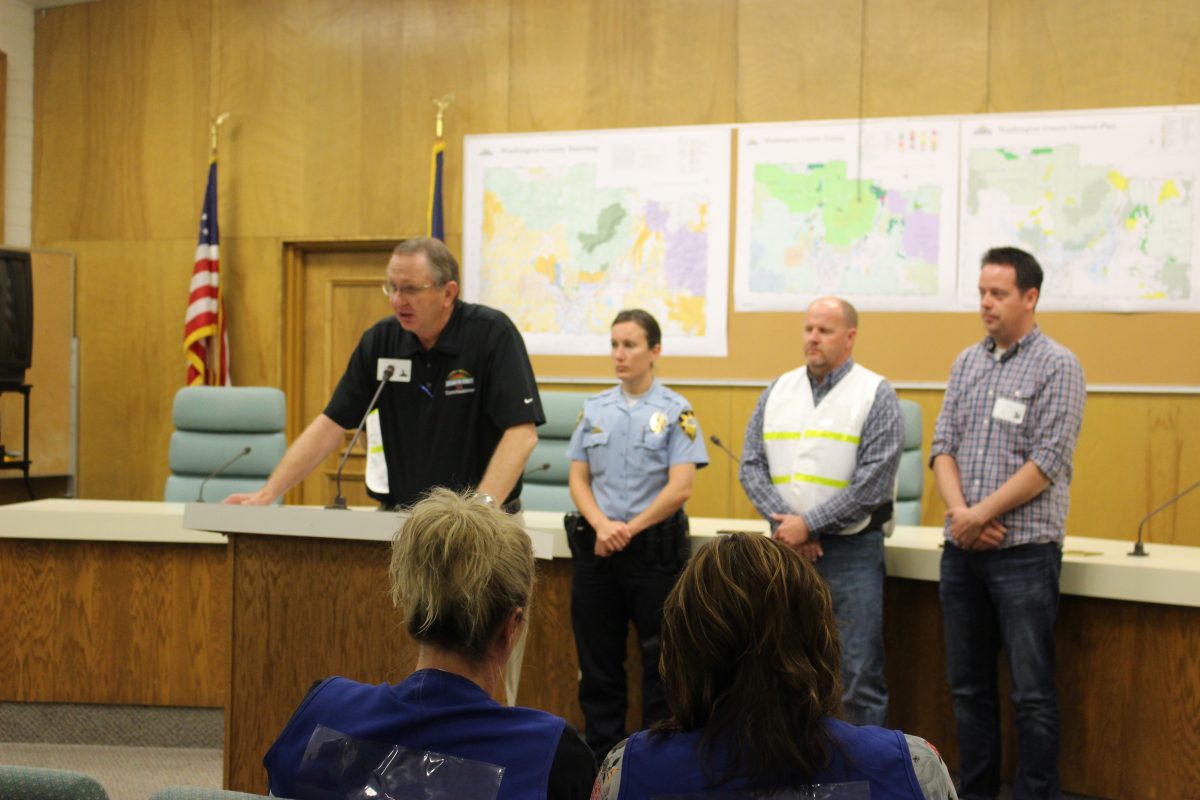ST. GEORGE — Earthquake safety was the focus Thursday as Utah’s largest earthquake drill, the “Great Utah ShakeOut” took place in counties throughout the state joining millions around the world as they practiced how to “drop, cover and hold on,” in preparation for the “big one.”
In Utah, nearly 992,000 people registered to participate in the annual earthquake drill, and more than 44,000 of them live in Washington County, according to data released by Be Ready Utah.
The drill encourages people across the state to practice earthquake safety procedures and provides simulated training exercises for the more than 122,000 participants from various local, state and federal agencies, along with nearly 41,000 businesses.

Thursday’s simulated exercise was held at the Emergency Operations Center located in the Washington County Building at 197 E. Tabernacle.
Agencies in attendance included damage assessment teams, Washington County Search and Rescue, law enforcement, the Bureau of Land management, firefighters, emergency medical personnel, amateur radio emergency services and several others.
In the simulated emergency, an earthquake with a magnitude of 6.0 hit the Washington City Fault at 11 a.m. Immediately following the quake a ‘Joint Information Center’ was set up. The center is designed to coordinate all emergency communication relating to the situation, as well as organizing emergency efforts and responsibilities, Peter Kuhlmann, emergency services director for Washington County, said.
“We are challenging our members to make decisions relative to responses to what would occur if we had suffered a 6.0 earthquake,” Kuhlmann said.
This enables officials to release information from one central location, which reduces delay and increases accuracy before the information is released to the public and the media in the event of an actual emergency, Dean Cox, Washington County commissioner, said. Cox previously served as the emergency manager for the county for 19 years.
Washington County utilizes the “Incident Command System,” Cox said, which is a management system designed to provide for effective and efficient incident management by integrating agencies, facilities, equipment and other resources using a common organizational structure.
During the drill, participants are encouraged to drop, cover and hold on. Just like they would in the event of a real earthquake, people should get as low to the ground as possible, cover their heads and hang onto nearby desks, chairs or any other sturdy object to protect themselves.
The training was made available to Washington County citizens to teach them the skills necessary to help themselves and their neighbors and to better prepare them to respond to and recover from the effects of emergencies.
“The community effort that has come together in all of Washington County,” Cox said, “working very hard collaboratively with each other to ensure to the very best degree possible the safety of our residents.”
According to shakeout.gov, “90% of Utah’s population lives in active earthquake zones.”
The website also states, “Large earthquakes are possible anywhere in Utah, but they are most likely in a ‘seismic belt’ about 100 miles wide extending north – south along the Wasatch Front and through Richfield to Cedar City and St. George. Utah averages a magnitude 6 earthquake once every 15 to 20 years.”
In southwest Utah, the last noticeable quake that occurred in the region happened the morning of July 4, 2015, near Panguitch. Located a little over one mile south of the town, the 3.9 quake shook the area, though no damage was reported. A few days before that, on May 22, a 4.8 quake hit 23 miles south-southwest of Caliente, Nevada, and was felt across Lincoln and Clark counties and southwest Utah as far as Hildale.
“It’s really not a question of ‘if’ they are going to happen,” Cox said, “its really ‘when’ they are going to happen.”
The Great Utah ShakeOut site has information on preparing a 72-hour-kit, earthquake guides that include one that addresses those with disabilities, audio and video broadcasts and other resources that will help families throughout Southern Utah in their efforts to prepare for an earthquake or other natural disaster.
As described by the ShakeOut community, the drill has three steps:
- DROP to the ground,
- COVER your head and neck with your arms and seek shelter by getting under a sturdy desk or table if nearby; and
- HOLD ON to your shelter and be prepared to move with it until the shaking stops.
Email: [email protected]
Twitter: @STGnews
Copyright St. George News, SaintGeorgeUtah.com LLC, 2017, all rights reserved.
2-10 story buildings fare the worst in these shakers.
And old, unreinforced masonry structures are deadly.
Just saying.